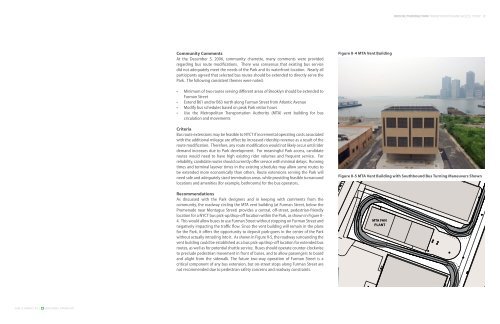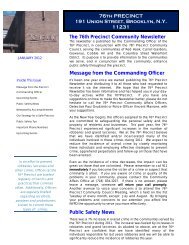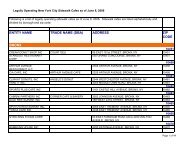Brooklyn Bridge Park Transportation Study, 3/2008
Brooklyn Bridge Park Transportation Study, 3/2008
Brooklyn Bridge Park Transportation Study, 3/2008
Create successful ePaper yourself
Turn your PDF publications into a flip-book with our unique Google optimized e-Paper software.
SAm SChwARTz PLLC hDR-DANIEL FRANkFURT<br />
Community Comments<br />
At the December 5, 2006, community charrette, many comments were provided<br />
regarding bus route modifications. There was consensus that existing bus service<br />
did not adequately meet the needs of the <strong>Park</strong> and its waterfront location. Nearly all<br />
participants agreed that selected bus routes should be extended to directly serve the<br />
<strong>Park</strong>. The following consistent themes were noted:<br />
•<br />
•<br />
•<br />
•<br />
Minimum of two routes serving different areas of <strong>Brooklyn</strong> should be extended to<br />
Furman Street<br />
Extend B61 and/or B63 north along Furman Street from Atlantic Avenue<br />
Modify bus schedules based on peak <strong>Park</strong> visitor hours<br />
Use the Metropolitan <strong>Transportation</strong> Authority (MTA) vent building for bus<br />
circulation and movements<br />
Criteria<br />
Bus route extensions may be feasible to NYCT if incremental operating costs associated<br />
with the additional mileage are offset by increased ridership revenue as a result of the<br />
route modification. Therefore, any route modification would not likely occur until rider<br />
demand increases due to <strong>Park</strong> development. For meaningful <strong>Park</strong> access, candidate<br />
routes would need to have high existing rider volumes and frequent service. For<br />
reliability, candidate routes should currently offer service with minimal delays. Running<br />
times and terminal layover times in the existing schedules may allow some routes to<br />
be extended more economically than others. Route extensions serving the <strong>Park</strong> will<br />
need safe and adequately sized termination areas, while providing feasible turnaround<br />
locations and amenities (for example, bathrooms) for the bus operators.<br />
Recommendations<br />
As discussed with the <strong>Park</strong> designers and in keeping with comments from the<br />
community, the roadway circling the MTA vent building (at Furman Street, below the<br />
Promenade near Montague Street) provides a central, off-street, pedestrian-friendly<br />
location for a NYCT bus pick-up/drop-off location within the <strong>Park</strong>, as shown in Figure II-<br />
4. This would allow buses to use Furman Street without stopping on Furman Street and<br />
negatively impacting the traffic flow. Since the vent building will remain in the plans<br />
for the <strong>Park</strong>, it offers the opportunity to deposit park-goers in the center of the <strong>Park</strong><br />
without actually intruding into it. As shown in Figure II-5, the roadway surrounding the<br />
vent building could be established as a bus pick-up/drop-off location for extended bus<br />
routes, as well as for potential shuttle service. Buses should operate counter-clockwise<br />
to preclude pedestrian movement in front of buses, and to allow passengers to board<br />
and alight from the sidewalk. The future two-way operation of Furman Street is a<br />
critical component of any bus extension, but on-street stops along Furman Street are<br />
not recommended due to pedestrian safety concerns and roadway constraints.<br />
Figure II-4 MTA Vent Building<br />
BROOKLYN BRIDGE PARK TRANSPORTATION AND ACCESS STUDY 10<br />
Figure II-5 MTA Vent Building with Southbound Bus Turning Maneuvers Shown<br />
MTA FAN<br />
PLANT




